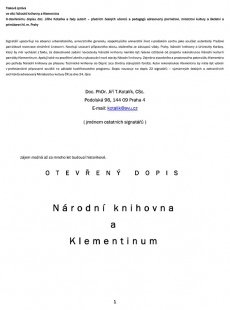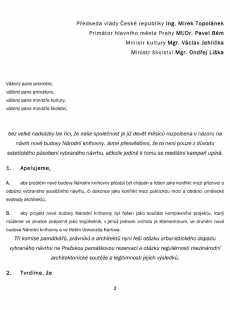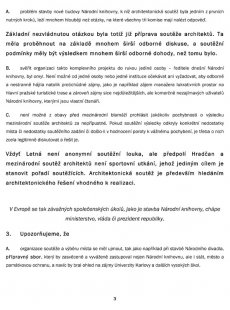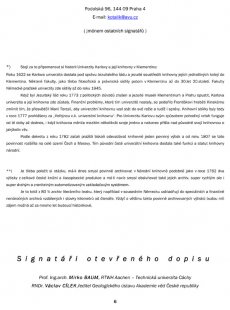
Open Letter: National Library and Klementinum
```html
The Mayor of Prague MUDr. Pavel Bém
The Minister of Culture Mgr. Václav Jehlička
The Minister of Education Mgr. Ondřej Liška
Dear Prime Minister,
dear Mayor,
dear Minister of Culture,
dear Minister of Education,
1. We appeal,
A. for the issue of the new National Library building to cease being understood and resolved as a conflict between supporters and opponents of the selected competition design, or even as a conflict between political power and defenders of artistic freedom of architects.
B. for the project of the new National Library building to be addressed as a part of a comprehensive project that we can briefly illustrate as a triangle, with Klementinum at one vertex, the new National Library building at another, and Charles University at the third.
2. We assert that
A. the issue of constructing a new National Library building, for which the architectural competition was one of the first necessary steps, lies much deeper than the questions that all three commissions are to answer.
The fundamental unresolved question was indeed the preparation of the architects' competition. It should have taken place based on a much broader professional discussion, and the competition conditions should have been the result of a much broader professional agreement than was the case.
B. to entrust the organization of such a complex project to a single individual - the director of the current National Library - was a mistake. It is not possible to expect or demand that one person or one institution expertly and impartially represent interests that are as contradictory as, for example, the interests of a manager of lucrative spaces on the main tourist route in Prague, along with the interests, albeit the most important, of the commercially uninteresting users of the National Library, who are the readers themselves.
C. it is unacceptable to declare any doubts about the results of the international architects' competition as impermissible out of fear of international embarrassment. If the competition results revealed specific shortcomings of the site or deficiencies in the competition assignment or if there was a serious error in the jury's evaluation, they must be discussed and resolved entirely legitimately.
3. We point out that
A. the organization of the competition and the selection of the site should have been undertaken, as was done during the construction of the National Theatre, by a preparatory committee that would represent not only the National Library but also the state, the city, and heritage protection in a knowledgeable and balanced manner, and also take into account the interests of Charles University and other higher education institutions.
The state, as the funding for the operation of Klementinum and the potential construction, operation, and maintenance of the new building will be covered by the state budget, i.e., from public funds.
The city of Prague, because the National Library is one of the most important components of the urban structure.
Heritage care, since the National Cultural Monument Klementinum is located in the center of the Prague Monument Reserve, and the National Heritage Institute and the Department of Culture and Heritage of the city hall are the main protectors of this property listed on the UNESCO World Heritage list.
Charles University, as most clients of the National Library are students and teachers of our oldest university, possibly the only school of comparable significance in the world that currently does not have its own university library.*)
B. the preparation of a potential new building for the National Library should not be addressed separately from the reconstruction or revitalization project of Klementinum and without prior resolution of the status and system of the University Library, respectively, a coherent system of faculty university libraries. As the 22 signatories - significant Czech and foreign architects emphasized in their letter to the Ministry of Culture of the Czech Republic dated October 24, 2007, it is necessary first and foremost to comprehensively evaluate the situation of the National Library and the spatial and construction potential of the Klementinum building after the relocation of the State Technical Library to its newly constructed building in Dejvice.**)
C. university and scholarly life and the artistic life it catalyzes mean an irreplaceable energy for every city that shapes its spiritual and subsequently architectural identity. The fact that the academic community still resides in the historical core of Prague and is not pushed to the periphery is one of the guarantees that the city will better withstand the adverse effects of the tourism industry.
B. objectively evaluate and describe the spatial and construction potential of the Klementinum building after the relocation of the State Technical Library to its newly constructed building in Dejvice
C. propose the form of competition that would produce the author of the urgent reconstruction of Klementinum.
In Prague, January 15, 2008
Doc. PhDr. Jiří T. Kotalík, CSc.
Podolská 96, 144 09 Prague 4
E-mail: kotalik@avu.cz
(on behalf of the other signatories)
*) It is worth recalling the history of Charles University and its library in Klementinum:
In 1622, Charles University came under the administration of the Jesuit Order, and the Jesuits concentrated the libraries of its individual colleges in Klementinum. Some faculties, such as the Faculty of Philosophy and the Faculty of Law, resided in Klementinum until the 1930s. The faculties of the German Prague University resided here until 1945.
When the Jesuit Order was dissolved in 1773 for political reasons, and the Jesuits had to leave Klementinum and Prague, Charles University and its library remained. The financial problems that arose for the university were alleviated by Count František Kinský, who persuaded Maria Theresa to take the university library into state management and therefore oversight. The library collections were declared "Public Imperial Royal University Library" in 1777. The comfortable relationship for Charles University has been functioning in this way until today, even though the library has since changed its name several times and ultimately lost any influence over its originally own library.
According to a decree from 1782, Prague printers began delivering one mandatory copy to the library, and since 1807 this obligation extended to the entire territory of Bohemia and Moravia. Thus, the originally purely university library also gained the function and status of a national library.
**) It is worth asking whether it makes sense today to mandatorily archive two copies of the total Czech book and journal production in the National Library, similarly to the practice in 1782, and whether it further makes sense to manage their archive with a super fast but also super expensive and vulnerable automated filing system.
It is, after all, 80% an archive of literary rubbish that, for example, in neighboring Germany is stored in special and financially low-cost archives even hundreds of kilometers away from the reader. After all, most of these mandatory archived copies will only be of interest to future historians possibly many years from now.
RNDr. Václav CÍLEK, director of the Geological Institute of the Czech Academy of Sciences
Ing. Ivan DEJMAL, landscape ecologist
Ware Professor of Architecture Kenneth FRAMPTON, Columbia University, N.Y.
Prof. MUDr. Jiří HOCH, CSc., surgeon, Faculty Hospital of Charles University in Motol
Prof. PhDr. Mojmír HORYNA, Vice-Rector for Science and Research, Charles University
Prof. academic sculptor Marian KAREL, educator at the AAAD
Doc.Ing.arch. František KAŠIČKA, Faculty of Architecture, Czech Technical University
Prof. Milan KNÍŽÁK, general director of the National Gallery in Prague
Prof. academic sculptor Stanislav KOLÍBAL
Doc. PhDr. Jiří T. KOTALÍK, CSc., art historian, educator at the Academy of Fine Arts
PhDr. Vladimíra KOUBOVÁ-EIDERNOVÁ, art historian, publicist
Dipl. architect Stanislav MAKAROV, educator at the School of Architecture in Aarhus (Denmark)
Prof. Ing. architect Miroslav MASÁK, Dr.h.c. of the Czech Technical University in Brno
Doc. Miroslav MELENA, scenographer, educator at the Faculty of Architecture, Technical University of Liberec
Dr. Ing. Miloslav PAVLÍK, CSc., Vice-Rector for Construction, Czech Technical University
Prof. Ing. academic architect Emil PŘIKRYL, director of the School of Architecture at the Academy of Fine Arts
Doc. PhDr. Ivan RYNDA, CSc., educator at the Faculty of Humanities, Charles University
Prof. Václav RIEDLBAUCH, general director of the Czech Philharmonic
Prof. Ing. architect František SEDLÁČEK, architect BDA, Technical University of Cologne
Prof. academic painter Jiří SOPKO, rector of the Academy of Fine Arts in Prague
Prof. Ing. academic architect Alena ŠRÁMKOVÁ, Faculty of Architecture, Czech Technical University
MgA. Marcela STEINBACHOVÁ, chairwoman of the Civic Association KRUH for the support of architecture
Prof. Alexander TOMSKÝ, B.Ed. M.A., publisher
PhDr. Luboš VELEK, PhD, deputy director of the Institute of Czech History, Faculty of Arts, Charles University
Prof. Aleš VESELÝ, sculptor
Prof. RNDr. Petr VOPĚNKA, DrSc. emeritus professor, Charles University
Prof. D.V. Ing. academic architect Dalibor VESELÝ, MAPhD., University of Cambridge
Doc. PhDr. Tomáš VLČEK, CSc., director of the collection of modern and contemporary art NG
Ing. academic architect Dana ZÁMEČNÍKOVÁ, glass artist ```
Press Release
Regarding the National Library and Klementinum
In response to the open letter from Doc. Jiří Kotalík and several authorities - leading Czech scholars and educators addressed to the Prime Minister, Minister of Culture and Education, and the Mayor of Prague
Signatories draw attention to the absence of an urban, university master plan that respects university life in the center of Prague as a part of the authenticity of the Prague Monument Reserve protected by UNESCO. They propose the establishment of a preparatory committee composed of representatives from the government, Prague, the National Library, and Charles University, which should be based on the fact that the discussed task of the new National Library building should not be addressed separately from the reconstruction project of the National Cultural Monument Klementinum. They also call for an examination of the intention to construct a new National Library building, particularly regarding the construction and spatial potential of Klementinum for the needs of the National Library after the relocation of the Technical Library to Dejvice (approximately a quarter of the current collections). The author of the Klementinum reconstruction should be selected in a professionally prepared competition based on a qualified program. This letter follows a letter from 22 signatories - significant Czech and foreign architects addressed to the Ministry of Culture of the Czech Republic dated October 24
Doc. PhDr. Jiří T. Kotalík, CSc.
Podolská 96, 144 09 Prague 4
E-mail: kotalik@avu.cz
(on behalf of the other signatories)
The Prime Minister of the Czech Republic Ing. Mirek TopolánekRegarding the National Library and Klementinum
In response to the open letter from Doc. Jiří Kotalík and several authorities - leading Czech scholars and educators addressed to the Prime Minister, Minister of Culture and Education, and the Mayor of Prague
Signatories draw attention to the absence of an urban, university master plan that respects university life in the center of Prague as a part of the authenticity of the Prague Monument Reserve protected by UNESCO. They propose the establishment of a preparatory committee composed of representatives from the government, Prague, the National Library, and Charles University, which should be based on the fact that the discussed task of the new National Library building should not be addressed separately from the reconstruction project of the National Cultural Monument Klementinum. They also call for an examination of the intention to construct a new National Library building, particularly regarding the construction and spatial potential of Klementinum for the needs of the National Library after the relocation of the Technical Library to Dejvice (approximately a quarter of the current collections). The author of the Klementinum reconstruction should be selected in a professionally prepared competition based on a qualified program. This letter follows a letter from 22 signatories - significant Czech and foreign architects addressed to the Ministry of Culture of the Czech Republic dated October 24
Doc. PhDr. Jiří T. Kotalík, CSc.
Podolská 96, 144 09 Prague 4
E-mail: kotalik@avu.cz
(on behalf of the other signatories)
The Mayor of Prague MUDr. Pavel Bém
The Minister of Culture Mgr. Václav Jehlička
The Minister of Education Mgr. Ondřej Liška
Dear Prime Minister,
dear Mayor,
dear Minister of Culture,
dear Minister of Education,
Without exaggeration, it can be said that our society has been divided for nine months over the proposal for a new National Library building. We are convinced that this is not only due to the aesthetic impact of the selected design, although that is the sole focus of the media campaign.
1. We appeal,
A. for the issue of the new National Library building to cease being understood and resolved as a conflict between supporters and opponents of the selected competition design, or even as a conflict between political power and defenders of artistic freedom of architects.
B. for the project of the new National Library building to be addressed as a part of a comprehensive project that we can briefly illustrate as a triangle, with Klementinum at one vertex, the new National Library building at another, and Charles University at the third.
Three commissions of preservationists, lawyers, and architects are currently addressing the issue of the urban impact of the selected design on the Prague Monument Reserve and the legitimacy of the international architectural competition and the legitimacy of its results.
2. We assert that
A. the issue of constructing a new National Library building, for which the architectural competition was one of the first necessary steps, lies much deeper than the questions that all three commissions are to answer.
The fundamental unresolved question was indeed the preparation of the architects' competition. It should have taken place based on a much broader professional discussion, and the competition conditions should have been the result of a much broader professional agreement than was the case.
B. to entrust the organization of such a complex project to a single individual - the director of the current National Library - was a mistake. It is not possible to expect or demand that one person or one institution expertly and impartially represent interests that are as contradictory as, for example, the interests of a manager of lucrative spaces on the main tourist route in Prague, along with the interests, albeit the most important, of the commercially uninteresting users of the National Library, who are the readers themselves.
C. it is unacceptable to declare any doubts about the results of the international architects' competition as impermissible out of fear of international embarrassment. If the competition results revealed specific shortcomings of the site or deficiencies in the competition assignment or if there was a serious error in the jury's evaluation, they must be discussed and resolved entirely legitimately.
After all, Letná is not an anonymous competition meadow, but the forecourt of Hradčany, and the international architectural competition is not a sports event whose sole aim is to establish the ranking of competitors. An architectural competition is primarily a search for an architectural solution suitable for implementation.
In Europe, such serious societal tasks, like the construction of the National Library, are understood by the ministry, the government, or the president of the republic.
3. We point out that
A. the organization of the competition and the selection of the site should have been undertaken, as was done during the construction of the National Theatre, by a preparatory committee that would represent not only the National Library but also the state, the city, and heritage protection in a knowledgeable and balanced manner, and also take into account the interests of Charles University and other higher education institutions.
The state, as the funding for the operation of Klementinum and the potential construction, operation, and maintenance of the new building will be covered by the state budget, i.e., from public funds.
The city of Prague, because the National Library is one of the most important components of the urban structure.
Heritage care, since the National Cultural Monument Klementinum is located in the center of the Prague Monument Reserve, and the National Heritage Institute and the Department of Culture and Heritage of the city hall are the main protectors of this property listed on the UNESCO World Heritage list.
Charles University, as most clients of the National Library are students and teachers of our oldest university, possibly the only school of comparable significance in the world that currently does not have its own university library.*)
B. the preparation of a potential new building for the National Library should not be addressed separately from the reconstruction or revitalization project of Klementinum and without prior resolution of the status and system of the University Library, respectively, a coherent system of faculty university libraries. As the 22 signatories - significant Czech and foreign architects emphasized in their letter to the Ministry of Culture of the Czech Republic dated October 24, 2007, it is necessary first and foremost to comprehensively evaluate the situation of the National Library and the spatial and construction potential of the Klementinum building after the relocation of the State Technical Library to its newly constructed building in Dejvice.**)
C. university and scholarly life and the artistic life it catalyzes mean an irreplaceable energy for every city that shapes its spiritual and subsequently architectural identity. The fact that the academic community still resides in the historical core of Prague and is not pushed to the periphery is one of the guarantees that the city will better withstand the adverse effects of the tourism industry.
The university life occurring in the city center is crucial for the preservation of its historical integrity and authenticity, valued also in the justification for the inscription of the Prague Monument Reserve on the UNESCO World Heritage list.
D. the National Library and Klementinum, which housed Charles University for three hundred years, with its University Library, we can without exaggeration call the epicenter of Czech education. The architectural development of Klementinum is a living textbook of architecture, sculpture, and painting. The anticipated reconstruction of Klementinum should not lower the established level of its artistic quality.The future author of the reconstruction of Klementinum should be selected through a demanding and well-organized architectural competition. Klementinum deserves its current Kilián Ignác Dietzenhofer, Carlo Lurago, or Ladislav Machoň.
4. Therefore, we recommend that all interested institutions, which are the Ministry of Culture of the Czech Republic, the Ministry of Education of the Czech Republic, the Municipality of Prague, the National Library, the National Heritage Institute, and Charles University, be called upon to form a preparatory committee.
This committee should prioritize:
A. to guarantee the development of a university urban master plan, within which system both the National Library and the University Library, respectively faculty university libraries, would obtain their logical systemic place and dimension.B. objectively evaluate and describe the spatial and construction potential of the Klementinum building after the relocation of the State Technical Library to its newly constructed building in Dejvice
C. propose the form of competition that would produce the author of the urgent reconstruction of Klementinum.
The gravity of the project of the new National Library can be fully appreciated against the background of the fact that since the construction of the National Theatre and the National Museum in the second half of the 19th century and the National Monument at Vítkov at the end of the First Republic, no building of comparable significance has been constructed in Bohemia.
Thank you for your attention.In Prague, January 15, 2008
Doc. PhDr. Jiří T. Kotalík, CSc.
Podolská 96, 144 09 Prague 4
E-mail: kotalik@avu.cz
(on behalf of the other signatories)
*) It is worth recalling the history of Charles University and its library in Klementinum:
In 1622, Charles University came under the administration of the Jesuit Order, and the Jesuits concentrated the libraries of its individual colleges in Klementinum. Some faculties, such as the Faculty of Philosophy and the Faculty of Law, resided in Klementinum until the 1930s. The faculties of the German Prague University resided here until 1945.
When the Jesuit Order was dissolved in 1773 for political reasons, and the Jesuits had to leave Klementinum and Prague, Charles University and its library remained. The financial problems that arose for the university were alleviated by Count František Kinský, who persuaded Maria Theresa to take the university library into state management and therefore oversight. The library collections were declared "Public Imperial Royal University Library" in 1777. The comfortable relationship for Charles University has been functioning in this way until today, even though the library has since changed its name several times and ultimately lost any influence over its originally own library.
According to a decree from 1782, Prague printers began delivering one mandatory copy to the library, and since 1807 this obligation extended to the entire territory of Bohemia and Moravia. Thus, the originally purely university library also gained the function and status of a national library.
**) It is worth asking whether it makes sense today to mandatorily archive two copies of the total Czech book and journal production in the National Library, similarly to the practice in 1782, and whether it further makes sense to manage their archive with a super fast but also super expensive and vulnerable automated filing system.
It is, after all, 80% an archive of literary rubbish that, for example, in neighboring Germany is stored in special and financially low-cost archives even hundreds of kilometers away from the reader. After all, most of these mandatory archived copies will only be of interest to future historians possibly many years from now.
Signatories of the open letter
Prof. Ing.arch. Mirko BAUM, RWTH Aachen - Technical University of AachenRNDr. Václav CÍLEK, director of the Geological Institute of the Czech Academy of Sciences
Ing. Ivan DEJMAL, landscape ecologist
Ware Professor of Architecture Kenneth FRAMPTON, Columbia University, N.Y.
Prof. MUDr. Jiří HOCH, CSc., surgeon, Faculty Hospital of Charles University in Motol
Prof. PhDr. Mojmír HORYNA, Vice-Rector for Science and Research, Charles University
Prof. academic sculptor Marian KAREL, educator at the AAAD
Doc.Ing.arch. František KAŠIČKA, Faculty of Architecture, Czech Technical University
Prof. Milan KNÍŽÁK, general director of the National Gallery in Prague
Prof. academic sculptor Stanislav KOLÍBAL
Doc. PhDr. Jiří T. KOTALÍK, CSc., art historian, educator at the Academy of Fine Arts
PhDr. Vladimíra KOUBOVÁ-EIDERNOVÁ, art historian, publicist
Dipl. architect Stanislav MAKAROV, educator at the School of Architecture in Aarhus (Denmark)
Prof. Ing. architect Miroslav MASÁK, Dr.h.c. of the Czech Technical University in Brno
Doc. Miroslav MELENA, scenographer, educator at the Faculty of Architecture, Technical University of Liberec
Dr. Ing. Miloslav PAVLÍK, CSc., Vice-Rector for Construction, Czech Technical University
Prof. Ing. academic architect Emil PŘIKRYL, director of the School of Architecture at the Academy of Fine Arts
Doc. PhDr. Ivan RYNDA, CSc., educator at the Faculty of Humanities, Charles University
Prof. Václav RIEDLBAUCH, general director of the Czech Philharmonic
Prof. Ing. architect František SEDLÁČEK, architect BDA, Technical University of Cologne
Prof. academic painter Jiří SOPKO, rector of the Academy of Fine Arts in Prague
Prof. Ing. academic architect Alena ŠRÁMKOVÁ, Faculty of Architecture, Czech Technical University
MgA. Marcela STEINBACHOVÁ, chairwoman of the Civic Association KRUH for the support of architecture
Prof. Alexander TOMSKÝ, B.Ed. M.A., publisher
PhDr. Luboš VELEK, PhD, deputy director of the Institute of Czech History, Faculty of Arts, Charles University
Prof. Aleš VESELÝ, sculptor
Prof. RNDr. Petr VOPĚNKA, DrSc. emeritus professor, Charles University
Prof. D.V. Ing. academic architect Dalibor VESELÝ, MAPhD., University of Cambridge
Doc. PhDr. Tomáš VLČEK, CSc., director of the collection of modern and contemporary art NG
Ing. academic architect Dana ZÁMEČNÍKOVÁ, glass artist ```
The English translation is powered by AI tool. Switch to Czech to view the original text source.







24 comments
add comment
Subject
Author
Date
hurá,
Vích
17.01.08 12:01
pozdě, ale přeci
Pepito
17.01.08 08:55
hmmmm
Filip Kastl
17.01.08 10:55
Nikdy není pozdě....
Pietro
17.01.08 11:23
To vše tu již je, jen jaksi zesunuto
AB
17.01.08 01:56
show all comments














